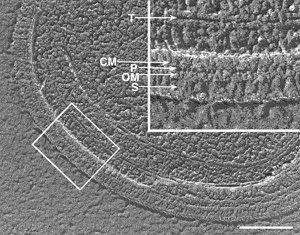Synechococcus and Biofuel: Difference between revisions
Cyoung9350 (talk | contribs) |
Cyoung9350 (talk | contribs) |
||
| Line 9: | Line 9: | ||
===Cell Structure=== | ===Cell Structure=== | ||
<i>Synechococcus</i> are coccoid shaped bacteria that range in size from 0.2-2 µm. They are classified as Gram-negative cells since the cell envelopes of these cyanobacteria structurally resemble those of Gram-negative bacteria, consisting of a cell membrane, peptidoglycan layer, outer membrane, surface layer, and sometimes additional structures. [http://www.biomedcentral.com/1471-2180/1/4[4]] [http://www.ncbi.nlm.nih.gov/pmc/articles/PMC2725629/[5]] [[Image:Cell_envelope.jpg|thumb|300px|right|Membrane structure of Synechococcus (strain WH8113) The inset corresponds to the outlined section of cell envelope comprising cell membrane (CM), peptidoglycan layer (P), outer membrane (OM), and surface layer (S). A thylakoid layer (T) is also indicated. This picture was published in 2001 by Aravinthan DT Samuel, Jennifer D. Petersen and Thomas S. Reese. | <i>Synechococcus</i> are coccoid shaped bacteria that range in size from 0.2-2 µm. They are classified as Gram-negative cells since the cell envelopes of these cyanobacteria structurally resemble those of Gram-negative bacteria, consisting of a cell membrane, peptidoglycan layer, outer membrane, surface layer, and sometimes additional structures. [http://www.biomedcentral.com/1471-2180/1/4[4]] [http://www.ncbi.nlm.nih.gov/pmc/articles/PMC2725629/[5]] [[Image:Cell_envelope.jpg|thumb|300px|right|Membrane structure of Synechococcus (strain WH8113) The inset corresponds to the outlined section of cell envelope comprising cell membrane (CM), peptidoglycan layer (P), outer membrane (OM), and surface layer (S). A thylakoid layer (T) is also indicated. This picture was published in 2001 by Aravinthan DT Samuel, Jennifer D. Petersen and Thomas S. Reese.[http://www.biomedcentral.com/1471-2180/1/4[6]]]] <i>Synechococci</i> species are both motile and non-motile, although many motile species appear to accomplish their movement without the aid of a flagella. Cells are thought to undergo locomotion through a gilding fashion, using filamentous protrusions (pili or spicules) to make contact with cell surfaces and move in a direction parallel to the filament (directional motility). [http://www.ncbi.nlm.nih.gov/pmc/articles/PMC15917/?tool=pubmed[7]] Swimming motility is believed to be accomplished by surface waves generated by filamentous protrusions. It is proposed that the waves are generated by a motor force embedded in the cell membrane, although the exact mechanism is unclear. [http://www.biomedcentral.com/1471-2180/1/4#B6[8]] | ||
===Envrionment & Lifecycle=== | ===Envrionment & Lifecycle=== | ||
Revision as of 09:43, 12 March 2014
Synechococcus is a genus of unicellular marine cyanobacteria that are found in both freshwater and marine water environments. They comprise a vast majority of picoplanktonic marine cyanobacteria. [1] Species in this genus are capable of photoheterotrophic, chemoheterotrophic, photoautotrophic, and even nitrogen fixation. [2] The genomes of several species of Synechococcus have been fully sequenced, most notably Synechococcus elongatus strain PCC 7942 and species strain WH8102. Due to the diversity in its metabolism as well as a genome that can be readily manipulated, Synechococcus holds potential for biofuel production via these metabolic pathways
Introduction
Classification
Taxonomy
Bacteria; Cyanobacteria; Chroococcales; Synechococcus [3]
Cell Structure
Synechococcus are coccoid shaped bacteria that range in size from 0.2-2 µm. They are classified as Gram-negative cells since the cell envelopes of these cyanobacteria structurally resemble those of Gram-negative bacteria, consisting of a cell membrane, peptidoglycan layer, outer membrane, surface layer, and sometimes additional structures. [4] [5]

] Synechococci species are both motile and non-motile, although many motile species appear to accomplish their movement without the aid of a flagella. Cells are thought to undergo locomotion through a gilding fashion, using filamentous protrusions (pili or spicules) to make contact with cell surfaces and move in a direction parallel to the filament (directional motility). [7] Swimming motility is believed to be accomplished by surface waves generated by filamentous protrusions. It is proposed that the waves are generated by a motor force embedded in the cell membrane, although the exact mechanism is unclear. [8]
Envrionment & Lifecycle
Metabolism
Discuss various pathways of metabolism
Biofuel Potential and Application
Hydrogen Fuel
Lipid-based Biodiesel
Electrical Fuel Cells
Issues in Current Development
Potential for Mass Production
Future Directions
Further Reading
[Sample link] Ebola Hemorrhagic Fever—Centers for Disease Control and Prevention, Special Pathogens Branch
References
Edited by (Caitlyn Young), a student of Nora Sullivan in BIOL168L (Microbiology) in The Keck Science Department of the Claremont Colleges Spring 2014.
